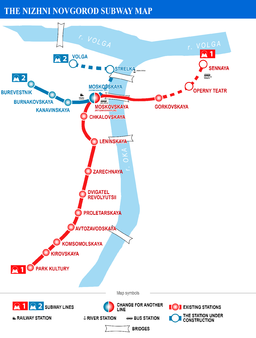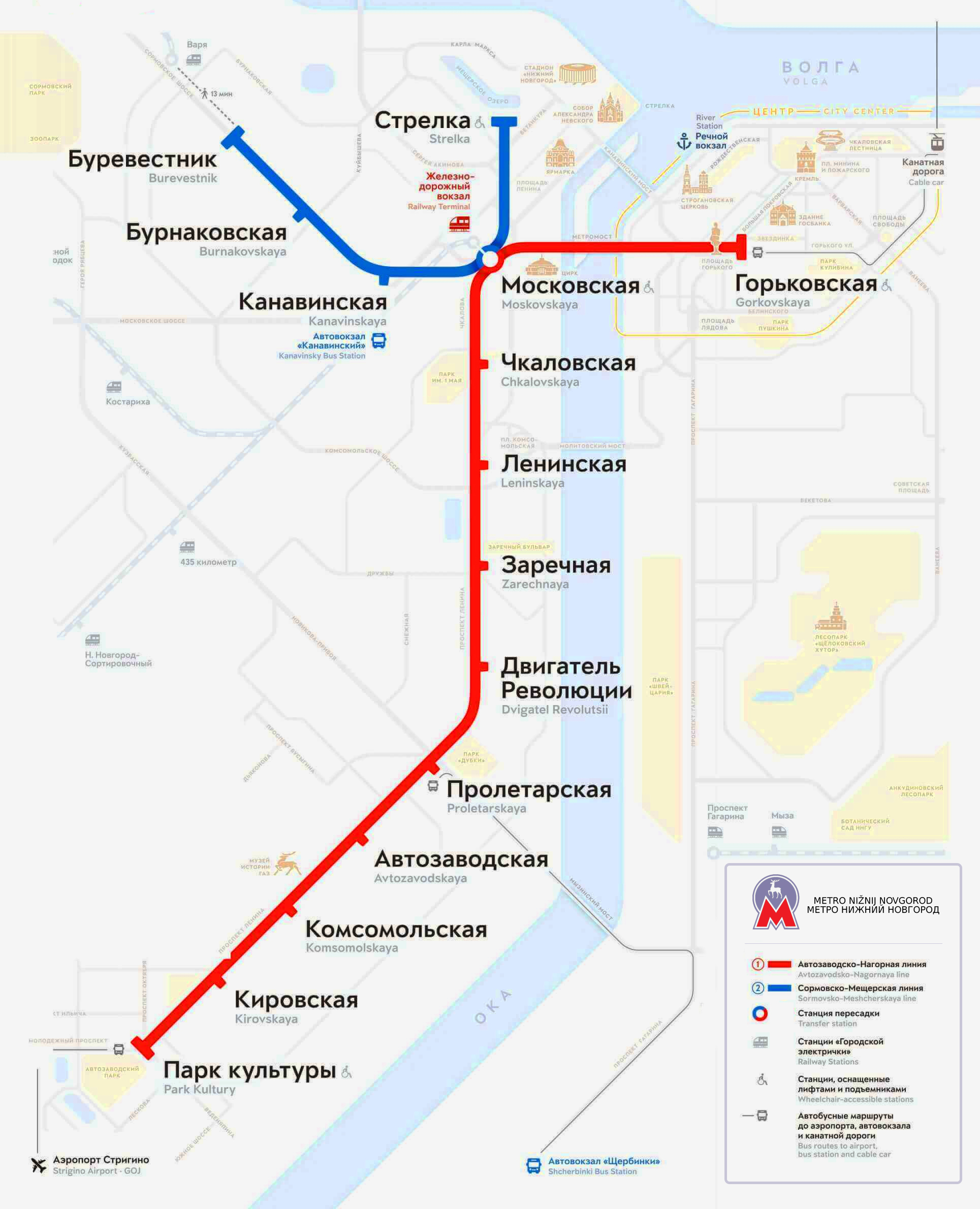One of the goals of the USSR was to develop underground transport systems in all of its major cities. When Gorki, as the city of Nizhny Novgorod was known during the Soviet era, passed the one million mark, the construction of a metro system became a necessity. Metrogiprotans, the leading company in the planning and design of Russian metros, took over the planning of the system, which began in 1970. The construction licence was granted in 1973, marking the official start of the design process.
The project was carried out quickly as the final designs for all the stations had already been established. On 15 July 1977, the Cabinet of Ministers of the USSR approved the construction of the Gorky Metro, and work began on 17 December of the same year.
The first metro line ran between Moskovskaya and Avtozavodskaya stations and was 9.6 kilometres (6 miles) long. Construction continued until 20 November 1985, when the first phase of the system was completed and inaugurated. The metro quickly underwent a series of extensions in 1987, 1989 and 1990. However, there was a significant hiatus at the beginning of 1993, when the metro was renamed to match the name of the city. It was not until 2002 that a new station was opened, and another ten years would pass before the next station was completed.
The Nizhny Novgorod metro carries around 109,500 passengers a day. It does not operate 24 hours a day, but only from 5.30 a.m. to midnight.
The trains are not air-conditioned and passengers cannot walk between platforms. The system does not use driverless trains and the platforms do not have screen doors.
The fare for a trip on the Nizhny Novgorod metro is 35 rubles in cash or 30 rubles by bank transfer.
Nizhny Novgorod Metro Map
Map of Nizhny Novgorod Metro showing different lines. Click on the map to enlarge it or download the Nizhny Novgorod map in PDF format.
Lines and Stations
The Nizhny Novgorod Metro currently has two operating lines with a total of 14 stations. The combined length of these lines is 18.18 kilometres (11.7 miles). The rolling stock of the system has undergone significant changes since the inception of the metro, but has always been maintained by the company Metrovagonmash.
The current model, 8-717/81-714, has been thoroughly modernised. The previously obsolete type D cars were used in Nizhny Novgorod until 1993.
Operations and Usage
In 2015, the annual number of passengers on the Nizhny Novgorod metro was 37.24 million, which translates into a daily ridership of about 141 thousand people. The Nizhny Novgorod Metro is managed by the city government. The basic fare for the system is 28 roubles (about $0.48 USD), and the operating schedule ranges from five to fifteen minutes in the morning to about twelve minutes after midnight.
Future Expansion
There are several major expansion plans for the Nizhny Novgorod metro. The city government aims to expand the system to better meet the transportation needs of its residents and to facilitate travel throughout the city. These plans reflect the continued growth and development of Nizhny Novgorod as a major urban centre in Russia.
Nizhny Novgorod Metro Map

This map shows the current layout of the Nizhny Novgorod metro, including its two operating lines and all 14 stations. As the city continues to grow and develop, the metro system is likely to expand to serve new areas and meet increasing passenger demand.
Access to the Airport
Nizhny Novgorod-Strigino International Airport serves as the main source of air traffic for the western Russian city of Nizhny Novgorod. Located approximately 14 kilometres (8.7 miles) from the city centre, the airport is located in the Avtozavodsky district, outside the city limits. At present, the airport has no rail, metro or suburban railway connections, although there are plans to introduce the latter. However, passengers can reach the metro by taking bus number 11 to the Park Kultury station on line 1. Marschrutka number 46 also provides a route to the same metro destination.
Operating Hours and Frequency
The Nizhny Novgorod metro stations open at 5:15 am, although some exits open at 7:00 am. The metro system generally closes at midnight, with specific closing times for each station between 12:05, 12:10 and 12:15. It’s important to note that some exits close earlier, at any time between these times and 19:00.
Timetables vary from line to line and station to station. For example, the longest line, Line 1, connects Gorkovskaya and Park Kultury stations. The first train leaves Gorkovskaya station at 5:32, although other stations have services up to 10 minutes earlier. The last train arrives at Park Kultury at 12:15. Frequency varies throughout the day and differs on weekends, when the first train leaves at 5:31 and the last at 12:12.
The first train on the Moskovskaya-Burevestnik line leaves at 5:20 and the last train arrives at Burevestnik at 12:28. The frequency of this line varies considerably throughout the day and is even lower at weekends, when the first train leaves at 5:20 and the last arrives at 12:27.
Pricing, Tickets, and Cards
The standard fare for a full trip on the Nizhny Novgorod metro is 28 rubles ($US 0.48). Unlike some other transit systems, there are no distance-based fares on this metro. Two types of payment are available. Traditional tokens, which are widely used on Russian metro systems, remain a popular method of payment for single journeys on the Nizhny Novgorod metro.
However, tokens have been known to cause problems due to their resemblance to low denomination coins, and their identical appearance to the tokens used in the St Petersburg Metro has caused additional security concerns. To distinguish them, holes were made in the centre of the tokens a few years ago. Meanwhile, the use of public transport cards is becoming increasingly popular.
These cards are becoming more widespread as they offer a cheaper journey at a cost of 26 roubles ($US 0.45). They allow a transfer to any of the city’s public transport systems within 60 or 90 minutes of entry. The cards cost 1000 roubles ($US 17.19) for the general public, with discounts available for students and senior citizens. Alternatively, an electronic rechargeable card can be purchased for 90 roubles ($1.55 USD), offering an even more economical long-term option.
System Regulations
- Luggage allowed on the Nizhny Novgorod Metro should not exceed 150 centimetres (59 inches) in total, with each dimension (width, height and length) not exceeding 120 centimetres (47.2 inches). Passengers with baggage exceeding these dimensions must purchase a baggage ticket and are limited to two pieces of baggage.
- It’s a good idea to keep to the right of the stairs if you’re not moving quickly.
- Sports equipment such as skateboards or ski equipment are subject to the same regulations as hand baggage.
- Children under 7 travel free of charge.
- Animals may be carried in cages or containers, except dogs, which must wear a muzzle.
Future Developments
Nizhny Novgorod’s metro currently serves five of the city’s eight districts. Although the tram network is considerably larger, there are plans to expand the metro to improve access throughout the city. Projects include the extension of Strelka station on the Sormoyskaya line to the Sormovo suburb and the construction of new stations in the city centre, including Sennaya and Operny Teatr.
The most ambitious project is the creation of Line 3, marked by the colour green and comprising 15 stations. This line, also known as the Mountain Line, will run parallel to Line 1, but along the banks of the Oká River.
Travel Tips
- In the event of a suspicious package, avoid using your mobile phone and notify the authorities immediately.
- If a passenger is involved in an accident, especially a fall on the underground, inform the authorities immediately.
- Always follow instructions and signs as they may vary from station to station.
Interesting Facts
- Only one station in the entire system is equipped for people with reduced mobility.
- The metro system was renamed when the city was renamed from Gorki to Nizhny Novgorod.
- There is a ‘ghost station’ called Yarmarka, which was abandoned during the construction of Strelka station.
Exploring Nizhny Novgorod via Metro
Despite its industrial past during the Soviet era, Nizhny Novgorod has many tourist attractions that are easily accessible by metro. These include
- Gorky Square: Accessible from Gorkovskaya Station on Line 1, Gorki Plaza is located close to the city centre, just a few blocks from the Kremlin. The square is open and surrounded by lush vegetation.
- Respublika Shopping Centre: One of the city’s main shopping centres, Respublika offers a vast and varied shopping experience. Despite parking issues raised by some shoppers, it’s conveniently located next to the Burevestnik metro station on line 2.
- GAZ History Museum: GAZ, a leading Russian car manufacturer based in Nizhny Novgorod, has a history museum featuring classic cars. To get to the museum, passengers should get off at either Avtozavodskaya or Komsomloskaya station on Line 1.
